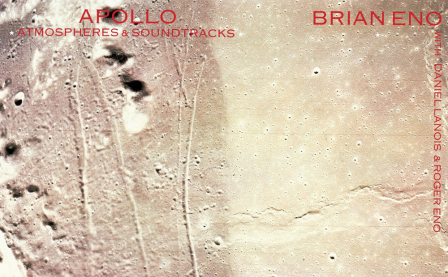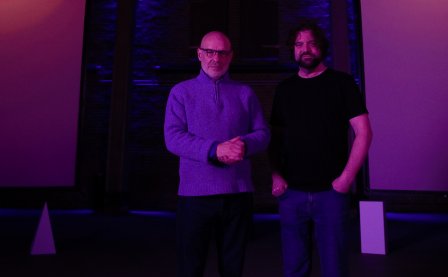Brian Eno completed the artwork for his latest Warp release, Drums Between The Bells, after spending time in São Paulo, “the most city-ish city in the western world.” The results, his photos of that cityscape put through the Photoshop grinder, look like Gordon Matta-Clark’s 1972 Walls Paper series, or posterized versions of Gerhard Richter scrapescapes, or the stuttering spread of an image under the pixel-thin incisions and misguided approximations of video codec failure. Although I’d be very willing in any case to judge a book (or any other text) by its cover, I feel it’s especially justified with Eno, an orchestrator — or should I say enabler — of images who intertwines his panmedial, inter-arts endeavors so thoroughly. For someone who created the clockwork for 77 Million Paintings, it is natural for Eno to sit at his computer (what treasures it must hold betwixt its folders) glitching out photos of the city ne plus ultra while listening to his forthcoming album on shuffle (the joker recommends eschewing the linear listen, for goodness’ sake); it is natural for him to find synesthesia stitching up the interstices between music and manipulated pixels.
Equally, it is natural for Eno to find affinities between poems and tones, to find each to be generative of the other. Lyrically, an impish, English, elegiac (from “King’s Lead Hat” to “St Elmo’s Fire”) poetic sensibility has always informed Eno’s solo work, and there’s the sense that this sensibility began to crystallize (or perhaps, with all respect, Eno began to get wise to midlife, that which we are always in) with the release of Another Day On Earth in 2005. This poetic crystallization is matched by a convergence upon a sound informed by a musical craft that embraces the fairly discreet, home-based- or desktop-studio-and-digital-workstation-oriented approach. Over and above Eno’s seminal and always experimental mentorship of the diverse forms of electronic music, to which the bedroom laptop producer owes loaf, the master himself indicates with these albums the ability for anyone with some basic tools and enough imagination to create music.
A track on Drums Between The Bells like “cloud 4”, with Eno’s multilayered voice modulating between intonation and generous song to deliver gently optimistic, contemplative lyrics over legato organ lines and softly arpeggiated synths, finds itself speaking to Another Day on Earth and the semi-titular track “Just Another Day.” This cluster itself speaks to the instrumental (I dare not say ‘voiceless’) meditations “The Big Ship,” “Sombre Reptiles,” and “Another Green World” that nestle at the center of 1975’s Another Green World. It’s a testament to his maturity and prescience that Eno can maintain a conversation with his past achievements, giving an impression of a sustained meditation on an eclectic bundle of decades-long vibrating strings, and that he remains as happy creating “three-dimensional instantiations” of poetry as he is setting poetry to music, and finding time between to promulgate as many permutations as can be mustered or set in motion.
Here, he takes a longstanding association with poet Rick Holland to the long-play listening experience, a format not to be too hastily deprecated, as long as wise, mercurial characters like Eno are around to keep the arts revivified. Even if you don’t take Eno’s advice to hit shuffle when listening to Drums Between The Bells, it’s a startling, diverse affair, a colorful, 16-track whirlwind of styles and sounds whose core, finally, is Holland’s word, Holland’s preoccupation with the science-fictional unfamiliarity of the present, the brightly lit obscurity of the media landscape, and clipped, abridged, glitched utterances. A core, then, that shines brightly through the scattered nebula of Drums Between the Bells because Holland’s word and Eno’s articulation are perfect partners.
But Eno can’t resist scattering this system, shuffling the deck by recruiting everyone from his Polish accountant to a sales assistant in a local store, a South African woman plucked from the street, and a Ukrainian graphic designer to provide voices for his fusion of the spoken word and what is so often given as the wordless speech of music. Ultimately, it is the heteroglossic impulse animating this collection of tracks, with music in the mix on par with a beautiful Babel of human voices, with music understood not simply as a backing track, with, vice versa, voice understood as musical form, syllables as sonic texture maps, that will act to polarize listenership. For example: opener “bless this space” beckons with fingers of deep and eerie funk, peppered with enigmatic incantations about the space of sounds and rhyme and guitar freakery courtesy of what sounds like the reanimated Ren & Stimpy house band high on no-wave swamp gas. Seductive moments like these rub shoulders (depending on how your shuffle function uncoils) with episodes more likely to alienate — that is, it will either engage or repulse listeners, depending on how the listener’s putative avant-gardism uncoils.
Thus, a track like “glitch,” which can’t help but be seen as best enacting Eno’s visual conceit for the album, can also act as a mutated piece of punkfunk where heavily vocoderizzled vocal bleatings help you work it on out (even if you don’t strictly work it out). Therefore, and only if you approach the album as music in the sense that ‘the words’ are of a distinct order (if still contingent upon the instrumentation), a track like “dreambirds” does in fact seem to function more as a piece of spoken word with a tonepoem of the Max Richter variety floating in the background. This can have the effect of diminishing the best tracks’ quivering synergy, the meta-stable equilibrium between poetry and music that is struck so well in tracks like “pour it out” (whose gestalt encompasses a micro-imaged, boldly orchestrated ballet of swooning biochemistry and blooming architecture), “dow” (speaking the poetry of the global financial system while mining Autechre’s “Basscadet”), tracks that hark back to the closer “Bone Bomb” on Another Day on Earth.
Then again, there are tracks that clearly foreground the poem but are just too compelling to ignore: “the airman” and the multiplexed moog and grime of “multimedia” (along with “dow”) are the raps of orbiting cyberpunks. And there are tracks that feature no poem except tone — “as if your eyes were partly closed as if you honed the swirl within them and offered me … the world” — even if here a caption is installed as a substitute for lyric. There are bizarre — that is, alien and overextended — moments, such as when the thrash-rap soundtracks of a thousand late-20th-/early-21st-century Matrix-alikes are summoned up by “sounds alien” (which to its credit also summons the crusty-acid best of Meat Beat Manifesto and provides the vocal cue for the album’s title) or the minute’s silence that a cynic would say was a pretentious gesture to mark out Eno’s art school chops.
But no — although I court the danger of raised eyebrows, it’s safe to say such an insert of absence is emblematic of Eno’s working methods. It’s a little plane of non-interference, a perfectly transparent facet, a place of no-word and no-sound, a seed upon which the album grows. Put it on shuffle and any of the 15 tracks may emerge from or evaporate into this pore that, on linear-listen, dissolves “cloud 4” and breathes life into the spooky, Badalamentian closing piece “breath of crows,” narrated by Eno.
Drums Between The Bells is challenging and complex, but evocative, rewarding, and not altogether fragmentary, not even (or especially) when you bust up the long-playing order. Eno hopes the record will “signal the beginning of a new way for poets to think about their work, and for audiences to think about poetry.” Without foolishly saying that this kind of hybrid has not been attempted before, Eno feels that “this is an idea whose time has come.” Whatever your opinion of such forms — and Eno’s inspirations in this family are diverse, from The Shangri-Las to spoken country to Schoenberg’s sprechstimme — this treasure trove is a sure sign that, in the right hands and in the right light, such strange flowers thrive, and this is finally a good thing.
Take off a star if you don’t like poetry readings. Add a half-star if you dig happenings with childlike wonder.
More about: Brian Eno




